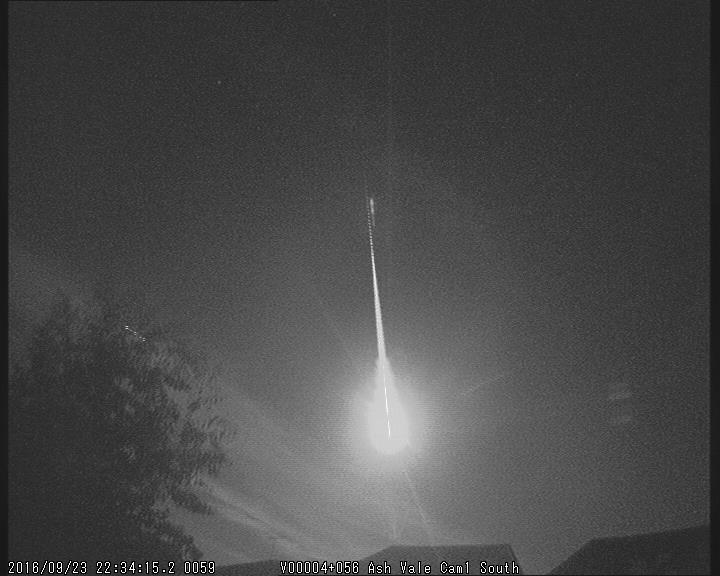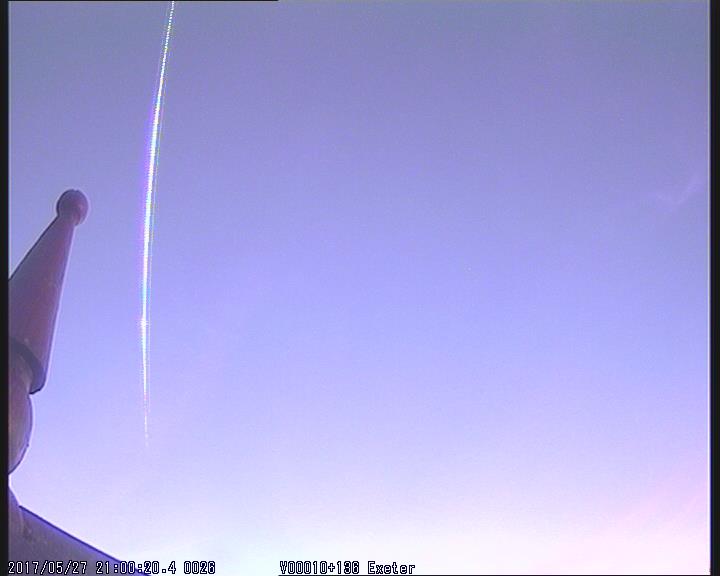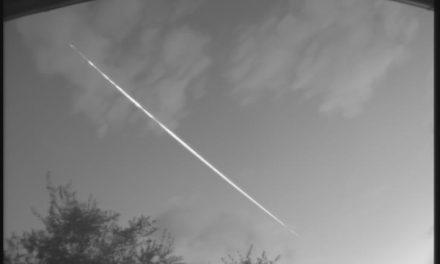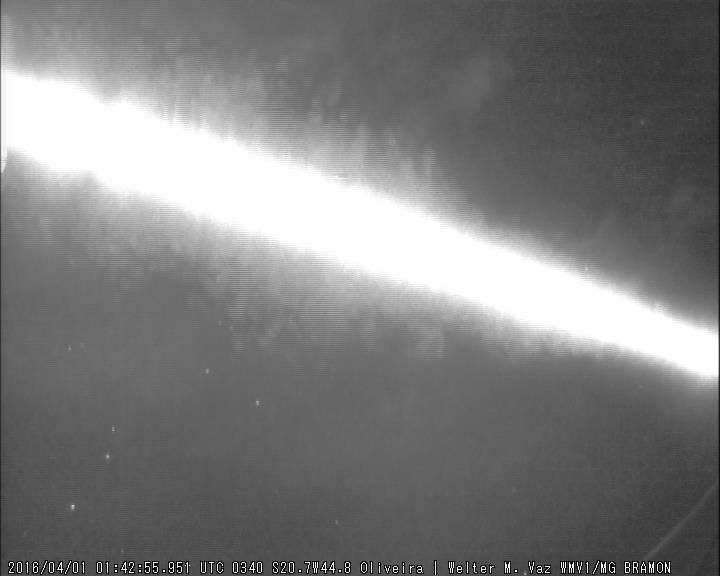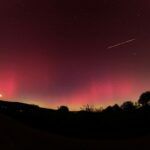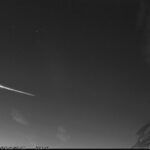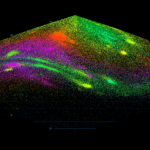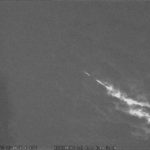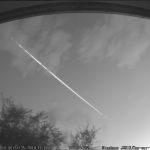The Eta Aquarids meteor shower originally belongs, like the October Orionids, to the well-known and most famous comet – 1P/Halley. Unlike the Orionids, whose radiant rises above the horizon in the late evening, the Eta Aquarids radiant rises about three hours before sunrise. Therefore, we can observe the meteors of this shower only just before dawn. This is exactly what happened on 9/5/2024 in the early morning hours (4h19m44s CEST), when a bright meteor (bolide) whose total ablation path exceeded 98 km was captured by the wide-field cameras of the CEMeNt network. Bright meteor was captured by two cameras at the Valašské Meziříčí Observatory and also by cameras at the Vsetín and Ždánice observatories. The spectrum of this bright meteor was also captured by one spectrograph at the Valašské Meziříčí Observatory, which is in test operation and provides high-resolution meteor spectra.
The maximum of the Eta Aquarids meteor shower usually occurs on 5/5 or 6/5 annually. However, the maximum of the shower is not sharp, so other secondary maxima may also occur in the nights around the maximum activity. The activity of the shower changes in a twelve-year period, the usual hourly frequency corrected for the zenith and ideal observation conditions reaches 40-60 meteors. For observers in Central Europe, the maximum hourly number of observed meteors from the low radiant height is only around 10.
The bolide 20240509_021944 was recorded by the CEMeNt network cameras on 9/5/2024 at 2h19m44.6 ± 0.1s UT. In the CEMeNt (Central European MetEor NeTwork), the bolide was recorded directly on four wide-angle cameras (Fig. 1-4). The flight record of the bolide is available from the stations Valašské Meziříčí NW and NE (CZ, Valašské Meziříčí Observatory), Ždánice E (CZ, Ždánice Observatory) and Vsetín E (CZ, Vsetín Observatory). In addition to these stations, the spectrum of the bolide was recorded by a spectrograph at the Valašské Meziříčí Observatory (spectrograph VM_SPNW), which is key for determining the chemical properties of the body.
ATMOSPHERIC TRAJECTORY, RADIANT AND HELIOCENTRIC ORBIT
To calculate the atmospheric trajectory of the bolide and the orbit of the meteoroid in the Solar System, recordings taken from the stations Valašské Meziříčí (NW and NE), Ždánice E and Vsetín E were used. The recordings from these stations was made by the UFO Capture, the recordings were processed in the UFO Analyzer and the atmospheric and heliocentric orbit was calculated in the UFO Orbit (SonotaCo, 2009). The projection of the beginning of the atmospheric trajectory was located at the coordinates N49.63340° E19.20912° near the village of Juszczyna (PL) south of Zywiec (PL), the height of the meteor at that moment was 120.2 km above the surface of the Earth. The projection of the end of the atmospheric trajectory was located at the coordinates N49.97394° E18.06282° near the village of Bažantnice (CZ) southeast of Kobeřice (CZ), the height of the meteor at this moment was 85.9 km above the Earth’s surface (Fig. 5). The bolide reached an absolute brightness of -5.6m and traveled a distance of 98.4 km in the Earth’s atmosphere during 1.5 seconds of flight.
The body entered the Earth’s atmosphere at a low angle of 20.5°, the speed before entering the atmosphere was 66.58 km/s. It was therefore a very fast bolide, the geocentric speed of the meteoroid was 65.37 km/s. The object belonged to the Eta Aquarids meteor shower (IAU MDC 0031 ETA). Before entering the atmosphere, the body moved along an elongated retrograde path (Fig. 6) with a high eccentricity e= 0.919, a high inclination to the ecliptic plane i= 163.26° and perihelion q= 0.5976. The body was of cometary origin with the parent body being 1P/Halley comet.
THE SPECTRUM OF THE BOLIDE
The spectrum of the bolide 20240509_021944 was recorded by the VM_SPNW spectrograph, which consists of a QHYIII-178M monochrome camera with a Sony IMX178 chip with a resolution of 3072 × 2048 px and a Tamron M118VG413IR varifocal lens. A fitted diffraction grating with a density of 1000 lines/mm provided a resolution of the captured spectrum of the bolide of 0.36 nm/px. The specified spectrographic assembly is in test operation, the summary image of the spectrum of the bolide from the spectrograph VM_SPNW (Fig. 7) and the calibrated spectrum of the FR7 image with the marking of the main emission lines of the spectrum of the bolide (Fig. 8) are shown below. This is a typical spectrum of a retrograde cometary particle with dominant atmospheric lines (OI, NI) and also dominant ionized calcium (CaII) lines. There are also other ionized lines in the spectrum, e.g. MgII, SiII or FeII, which are also typical for the spectra of this type of bodies.
ACKNOWLEDGMENT
Thanks go to all operators and owners of stations in the CEMeNt network. Thanks also go to all involved institutions for supporting the activities and growth of the network. The RPOS project (Cross-Border Observational Network Development) was co-financed from the Small Projects Fund of the Interreg V-A Program Slovakia – Czech Republic 2014 – 2020, call code 5/FMP/11b, reg. no. CZ/FMP/11b/05/058. The KOSOAP (Cooperating Network in the Field of Astronomical Observation Programs) and RPKS (Development of Cross-Border Cooperating Network for Professional Work and Education) projects were implemented by the Valašské Meziříčí Observatory (Czech Republic) and the Kysucké Nové Mesto Observatory (Slovakia) in cooperation with SMPH (Society for Interplanetary Matter). The projects were co-financed from the Micro-Projects Fund of the Operational Program for Cross-Border Cooperation Slovakia – Czech Republic 2007-2013. The purchase and operation of high-resolution spectroscopic cameras are partially funded by the Program for Regional Cooperation of the Czech Academy of Sciences, reg. no. R200402101 and grant APVV-0517-12 (FMFI UK). The purchase of instrument equipment located at the Valašské Meziříčí Observatory, p.o., was also supported by DEZA, a.s. and CS CABOT, spol. s r.o.
REFERENCES
SonotaCo (2009). A meteor shower catalog based on video observations in 2007-2008. WGN, Journal of the International Meteor Organization 37:2, 2009, p. 55-62.









